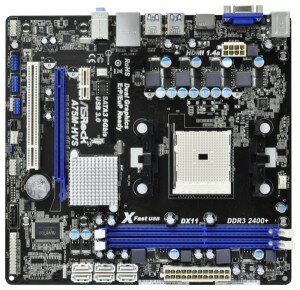The introduction of Fusion processors for desktops has come alongside a new processor socket, called FM1, and two new motherboard chipsets called A55 and A75. Of the two, only A75 is available thus far, and it’s likely the only one a consumer building his or her own PC would want in the first place. That’s because the A75 provides solid USB 3.0 and SATA 6 Gbps support, while the A55 doesn’t.
Fusion is an attractive HTPC option because of the high-quality graphics integrated in the chip, but the processor needs to be paired with a decent Micro-ATX motherboard. In this case, that’s not hard to find, because the majority of A75 motherboards make use of Micro-ATX instead of the full ATX form factor. Let’s have a look at three excellent solutions.
ASRock A75M-HVS
Simple, basic, cheap. Those aren’t exciting words, but sometimes they’re a better alternative than overpriced and complex – and besides, this is motherboards we’re talking about. They’re the pinnacle of sexy to begin with.
If you are building on a budget and don’t want or need many features, the ASRock A75M-HVS will suit you. Its main advantage is the price of $69.99, and its main feature is the fact that it will accept a Fusion processor and then turn on. Okay, that’s being a little harsh, but you won’t find super-advanced fan controls or sixty ways to overclock. What you will find is the basic features all A75 motherboards have including USB 3.0 support, Gigabit Ethernet, HDMI and one of each type of PCI slot (Express x16, x1 and vanilla).
Gamers and advanced users should steer clear of this board, but those constructing a simple media center or a home/office PC for Mother Deariest should be happy with what this board offers.
Buy the ASRock A75M-HVS on Newegg.
A step up from the ASRock, this board comes from Gigabyte, one of the most well respected and reliable brands in the motherboard market. Priced at $89.99, this Gigabyte board is a full $20 bucks more expensive than the ASRock, but it provides a few extra features for the extra dough.
This includes an additional PCI Express x16 slot, better audio in the form of a Realtek audio chip with support for 8 channels, support for up to 32GB of RAM, and a huge variety of connections including FireWire, eSATA 6Gbps and DisplayPort in addition to more mundane options like USB 3.0 and HDMI. There is also on-board FireWire for additional connectivity via a enclosure’s front FireWire port.
Builders wanting to construct a media center will be happy with this board’s reliability, but connectivity is the big story. This would be an excellent board for a small but powerful home/office workstation.
.
Often, system builders construct a small system because it needs to be inexpensive. Smaller motherboards and enclosures tend to cost less, and since there’s no need for expensive add-on cards, they don’t lead to space constraints. Even an enthusiast may want to build a small, inexpensive, but powerful system, and the ASUS F1A75-M Pro is among the best platforms for doing that.
The F1A75-M Pro has all the expected chipset features as well as Realtek 8-channel audio, but it’s the custom features provided by ASUS that set it apart. This includes the best fan speed controls in the industry, the best UEFI BIOS in the industry, and a superb software overclocking utility. ASUS makes it really simple to extract the most out of a system built on this motherboard.
Connectivity is the only flaw – it’s decent, but there’s no DisplayPort, eSATA or FireWire. The Gigabyte is clearly the winner in that regard. This board is also a tad more expensive at $109.99. Not everyone will need those extra ports, however. The F1A75-M Pro’s fan speed and overclocking features makes it particularly appealing to gamers.
.




You must log in to post a comment.